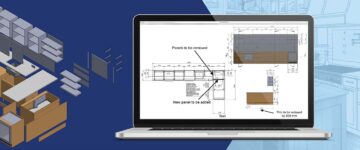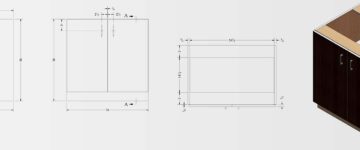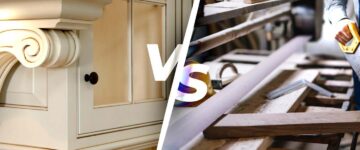- Specialized CAD design drafting firms handle multiple projects simultaneously, ensuring quick results through their flexibility and scalability, without compromising quality.
- Outsourcing millwork shop drawings reduces overhead by turning fixed costs into variable ones, paying only for needed services.
- Outsourcing grants access to skilled professionals who ensure high standards of accuracy in shop drawings.
Table of Contents
Architectural millwork is a precise and intricate field that requires detailed planning and execution. One critical aspect of this process is the creation of millwork shop drawings, which serve as blueprints for manufacturing and installing millwork components.
As the demand for high-quality, custom millwork grows, so does the need for accurate and detailed shop drawings. Many joinery makers have found that outsourcing joinery drawings to specialized firms can provide significant advantages.
Challenges for architectural millwork shop drawings in CAD designing
- Skill Gap and Training: Ensuring that all team members are proficient in the latest CAD tools through continuous training, which is expensive.
- Technological Advancements: Keeping up with constantly evolving CAD software and regularly updating and learning to use new features.
- System Integration: Seamlessly integrating CAD with other design and manufacturing systems, requiring specialized knowledge and custom solutions.
- Accuracy and Detail: Maintaining precision in CAD drawings to avoid significant manufacturing and installation issues.
- Time Constraints: Balancing speed and quality of millwork detailing in CAD drawings under tight project deadlines.
- Customization Complexity: Creating unique, custom CAD drawings that meet client specifications while adhering to industry standards.
- Collaboration and Communication: Ensuring effective collaboration and communication among designers, engineers, and clients to prevent errors and rework.
- Data Management and Security: Organizing, accessing, and securing large volumes of CAD files to prevent data loss and unauthorized access.
While architectural millwork firms face significant challenges in CAD design, from maintaining accuracy and managing costs to keeping up with technological advancements, outsourcing these tasks can provide an effective solution. By partnering with specialized firms, millwork companies can overcome these obstacles and leverage numerous advantages, enhancing their efficiency and project outcomes. Here are the top five benefits of outsourcing shop drawings in architectural millwork.
Top five benefits of outsourcing architectural millwork shop drawings

1. Scalability and Flexibility
The ability to scale operations quickly is a major advantage of outsourcing. Millwork companies often face fluctuating workloads, with periods of high demand followed by slower times. Maintaining an in-house team that can handle these fluctuations can be challenging and costly.
Outsourcing provides the flexibility to scale up or down based on project needs. Specialized firms can quickly ramp up their efforts to meet increased demand or scale back during slower periods. This flexibility allows millwork companies to manage their resources more effectively and avoid the costs associated with hiring or laying off staff.
2. Access to Expertise
Outsourcing shop drawings provides access to a pool of highly skilled professionals who specialize in creating detailed and accurate drawings. These experts have extensive experience in architectural millwork and are familiar with the latest industry standards and best practices.
Specialized firms invest heavily in training their staff and keeping them updated with the latest advancements in CAD technology. This means that outsourced teams are often more adept at handling complex projects and can produce higher-quality drawings than an in-house team might be able to. By leveraging this expertise, millwork companies can ensure that their projects meet the highest standards of accuracy and precision.
3. Faster Turnaround Times
Time is a critical factor in the construction and millwork industries. Delays in the production of shop drawings can lead to project bottlenecks and increased costs. Outsourcing can significantly speed up the drawing process, as specialized firms have the resources and personnel to handle multiple projects simultaneously.
Outsourcing firms are structured to deliver quick turnaround times without compromising quality. They often employ dedicated teams that focus solely on producing shop drawings, allowing them to complete tasks more efficiently than an in-house team that might juggle multiple responsibilities. This increased efficiency can help millwork companies meet tight deadlines and keep their projects on track.
4. Cost Efficiency
One of the most compelling reasons for outsourcing shop drawings is the potential for cost savings. Maintaining an in-house team of skilled CAD drafters and engineers can be expensive. Salaries, benefits, and ongoing training all contribute to high overhead costs. Additionally, the costs associated with software licenses and equipment maintenance can add up quickly.
Outsourcing to a specialized firm allows millwork companies to convert these fixed costs into variable costs, paying only for the services they need when they need them. This model of work eliminates the need for long-term financial commitments and can lead to significant savings. Furthermore, outsourcing firms often operate in regions with lower labor costs, which can further reduce expenses without sacrificing quality.
5. Focus on Core Competencies
By outsourcing shop drawings, millwork companies can free up their internal resources to focus on their core competencies. Instead of spending time and energy creating detailed drawings, they can concentrate on what they do best—fabrication and installation.
This focus reorientation can lead to increased productivity and efficiency, as employees are able to devote their full attention to critical tasks that directly impact the quality and success of their projects. Additionally, by partnering with a specialized firm, millwork companies can benefit from a collaborative approach, combining their expertise in fabrication with the drawing firm’s expertise in design.

The Future of Millwork Shop Drawings: Trends and Innovations to Watch
- 3D visualization in CAD enhances conflict detection.
- Macros enable drawing task automation.
- API integration streamlines workflow.
- AR facilitates better visualization and collaboration.
Ideal Process of Outsourcing Millwork Shop Drawings
The process of outsourcing architectural millwork shop drawings typically involves the following steps:
Client (typically an architectural firm or a millwork manufacturer) Provides
- Millwork design specifications and requirements
- Architectural drawings and plans
- Material details and finishes
Outsourcing Firm Responsibilities
- Review client’s millwork design requirements and architectural plans
- Develop detailed shop drawings for fabrication and installation
- Create accurate 2D plans, elevations, sections, and details
- Generate 3D models and renderings for visualization
- Ensure drawings adhere to industry standards and client specifications
- Provide shop drawings for client review and approval
- Incorporate client feedback and revise drawings as needed
Millwork Fabricator Responsibilities
- Provide input on constructability and fabrication methods
- Review and approve final shop drawings before fabrication
- Fabricate millwork components based on approved shop drawings
Collaborative Process
- Outsourcing firm works closely with client and millwork fabricator
- Frequent communication to clarify requirements and provide updates
- Iterative review process to refine shop drawings before fabrication
By outsourcing the shop drawing process, clients can benefit from:
- Access to specialized expertise and CAD drafting capabilities
- Reduced in-house staffing requirements and overhead costs
- Faster turnaround times and improved project efficiency
- Consistent quality and adherence to industry standards
The key to successful outsourcing is selecting a reliable partner with experience in architectural millwork shop drawings and a proven track record of delivering high-quality results on time and within budget.
Conclusion
Outsourcing shop drawings in architectural millwork offers numerous advantages, including cost efficiency, access to expertise, faster turnaround times, scalability, and the ability to focus on core competencies. By partnering with a specialized firm, millwork companies can enhance their operational efficiency, improve the quality of their projects, and ultimately deliver better results to their clients.
If you are considering outsourcing your shop drawings, our company offers detailed engineering drawings in CAD tailored to meet the needs of millworkers in the US, UK, and Europe. Contact us today to learn more about how we can help streamline your operations and improve your project outcomes.







